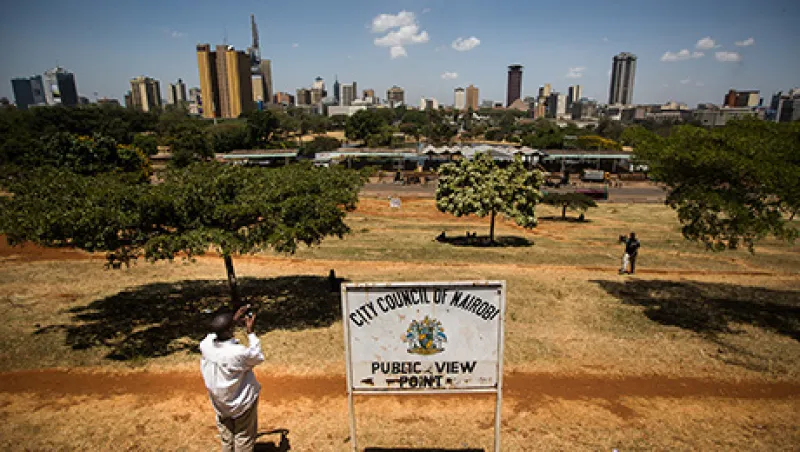African countries have taken advantage of the growing appetite for emerging-markets debt in recent years to tap the international capital markets. But the path from investment pariah to party favorite isn’t always a smooth one.
Consider the case of Kenya. The government is preparing to sell between $1.5 billion and $2 billion in Eurobonds. Investors are expecting a yield of about 7 percent, based on outstanding international bond issues by sub-Saharan African governments. Aly-Khan Satchu, CEO of Nairobi–based investment and advisory firm Rich Management, says the rate would be about 6.75 percent if Kenya were to sell $1.5 billion and 7.25 percent if that amount were to rise to $2 billion.
Kenya’s credit ratings have remained steady. Fitch and Standard & Poor’s give the country a B+ rating, and Moody’s rates it at B1. The government intends to use the proceeds to pay off a $600 million syndicated loan, which comes due on August 15, and for “general budgetary purposes including the funding of infrastructure projects,” according to a prospectus released June 5 in conjunction with the kickoff of an investor road show. The loan’s lead managers and book runners are Barclays, J.P. Morgan Securities, Qatar National Bank and Standard Bank of South Africa.
Kenya has several key infrastructure projects planned that could be funded with the proceeds, including railroad projects inland from its coastal ports. A source says one such possible project is a 1,500-kilometer railroad from Lamu on Kenya’s northern coast to the country’s border with South Sudan.
Bonds-for-infrastructure is a common model in Africa, as a lack of roads, power, Internet connectivity and other public works is perceived as a crimp on growth across the continent. Several sub-Saharan countries — including Ghana, Nigeria, Rwanda, Senegal and Zambia — have issued Eurobonds in recent years. Those countries have taken advantage of the positive investor sentiment associated with the Africa Rising narrative, the search for yield prompted by U.S. Federal Reserve’s quantitative easing program and a souring outlook for some more established emerging-markets sovereigns such as Brazil and Turkey.
But some leading African nations are beginning to fall out of favor as well. Ghana and Zambia, each of which has tapped the Eurobond market twice since 2007, are now struggling with costly public sector payrolls and other high, recurring expenses that are diverting funds intended to be spent building infrastructure. “The current fiscal stance is unsustainable,” the International Monetary Fund said in its January 9 Article IV report on Zambia. The country, Africa’s second-largest producer of copper, raised more IMF alarm bells on June 6 when the country asked for more help from the international agency amid sliding copper prices, which have led to a depreciation in value of the kwacha, the national currency. This is on top of the steep rise in public sector wages. Zambia’s annual GDP growth has averaged some 6.4 percent during the past decade, although the country’s deficit spending is roughly 8.6 percent of GDP. Zambia’s bond sale in April, which raised $1 billion for the country, came in at a rate of 8.625 percent. But the announcement on Friday that Zambia needed more support sent the yield on that bond issue down 52 basis points on the day to an all-time low of 6.93 percent.
In the case of Ghana, the country’s July 2013 Eurobond issue came in at 7.875 percent. Deficit spending runs at nearly 11 percent of GDP. “Current vulnerabilities put Ghana’s transformation agenda at risk,” writes the IMF in its Article IV outlook on the country. Like Zambia, it also has its share of foreign exchange woes. The Ghanaian cedi has hit an all-time low against the dollar, approaching 3 to the U.S. dollar in early June. This is on top of the deficit, which has prompted the government to consider both an IMF loan package and another sovereign bond sale. Analysts estimate that any new bond would have to carry a yield in the 8 to 9 percent range.
The three main ratings agencies agree that the countries’ outlooks have worsened. Both Ghana and Zambia have either been downgraded or seen their outlooks dropped to negative from stable in the past year. All three ratings agencies have a negative outlook for Ghana: Fitch and S&P give the country’s sovereign bond a B rating; Moody’s rates the West African country’s credit at B1. As for Zambia, Fitch gives the country’s bond a B rating with a stable outlook; Moody’s, B1 with a stable outlook; and S&P, B+ with a negative outlook.
Kenya, however, is in better fiscal shape. The country completed an IMF loan program in 2013, met all fiscal targets set for it and won significant praise. The IMF wrote in a December report, “Kenya’s recent reforms have introduced a more comprehensive system of checks and balances, including accountability and transparency in expenditure control and management.”
Kenya is the third-largest economy in sub-Saharan Africa, after Nigeria and South Africa. Unlike many of the continent’s other heavyweights, its diversified economy isn’t dominated by oil, gas or mining; those activities provide less than 1 percent of Kenya’s gross domestic product. Agriculture is the largest sector, accounting for some 25 percent of GDP, whereas financial services, industry and tourism each contribute more than 9 percent, according to the central bank.
The country is widely considered to have a healthy balance sheet. The debt-to-GDP ratio in Kenya, according to the June 5 prospectus, which is based on end-2013 numbers, is 50.7 percent. The IMF’s December report projected that the country’s debt would stand at 45.1 percent of GDP at June 30, the end of Kenya’s fiscal year, whereas external debt — the Eurobond would fall into this category — would amount to 22.9 percent.
The government considered a Eurobond in 2012, but market conditions weren’t favorable at the time. The country was preparing for the general elections of 2013 and the previous vote, in 2007, triggered street violence. Kenya was also embarking on a complicated process of devolving some political functions to 47 newly created counties. As a result, the government instead opted for a $600 million syndicated loan underwritten by Citigroup, Standard Chartered Bank of the U.K. and Standard Bank of South Africa. It used the money to finance a mix of roads, energy and irrigation projects.
Another important reason for Kenya’s delay in selling a Eurobond was the lingering effects of what’s known in the country as the Anglo-Leasing scandal. Tenders for security contracts were awarded to phantom companies in 1997 in exchange for kickbacks to government officials. The fallout included a series of lawsuits in European courts, and the government was ordered to pay 18 contractors to honor some of the contracts, worth about $18 million.
“We’ve suffered the blowback from this misadventure over a number of years,” says Rich Management’s Satchu. “But people appreciate that this is a legacy the current government has inherited.”
A concern is that if Kenya does not make those payments, contrary to what is spelled out in the prospectus, the proceeds from an international bond sale could be seized to satisfy the judgments. President Uhuru Kenyatta has supported making the payments, but the country’s Parliament has thus far denied the government permission to do so. “Putting in detail about what the money will be used for is showing a sensitivity to market conditions in 2014,” says Satchu. “Eurobond investors want to see their money spent on specific projects.”
The various factors weighing against a sovereign bond sale ultimately run the risk of raising the cost of finance.
A recent research note from Fitch cited the potential risk to reserves in indebted countries if they cannot continue accessing international markets when large debt payments come due, forcing them to use their reserves instead. “It highlights the risk to reserves in the event the bond had to be repaid and the country is unable to gain access to the market,” says Carmen Altenkirch, director of sub-Saharan Africa ratings at Fitch in London.
These are countries that have in the past relied on concessional or donor financing from the International Monetary Fund, aid agencies and others. Economic growth and increased creditworthiness have enabled more African countries to tap global capital markets, but that can mean higher debt-servicing costs. Investors, accordingly, are looking more carefully at the country’s fundamentals and spending plans. Like Kenya’s June 5 prospectus, “recent sub-Saharan African bond prospectuses have included details about how the proceeds will be used, which is not common elsewhere,” says Altenkirch.
If sub-Saharan African countries make a habit of using the Eurobond market, which offers higher interest rates than the concessional debt from which Africa has often benefitted in the past, according to Altenkirch, “the focus will increasingly fall on whether projects are earning a suitably high rate of return.”
Get more on emerging markets and on fixed income.






